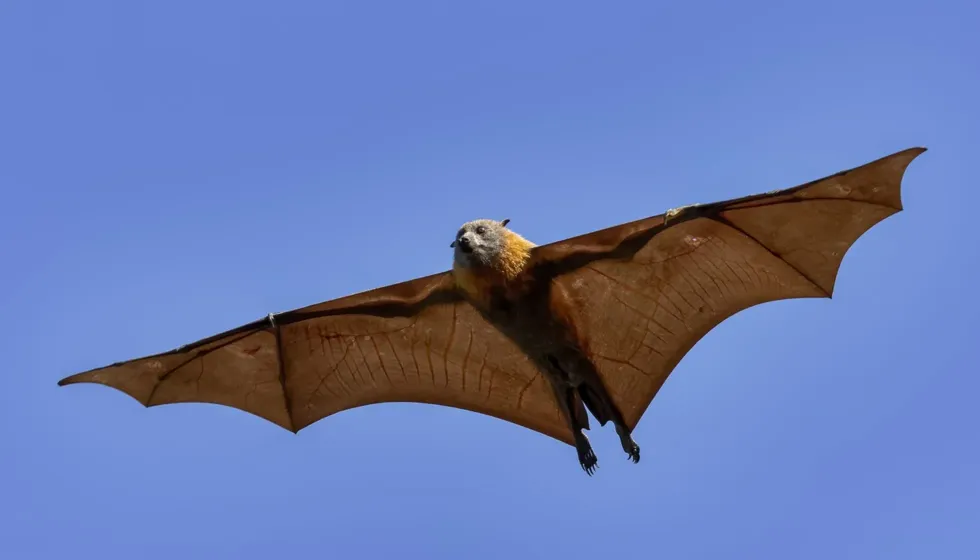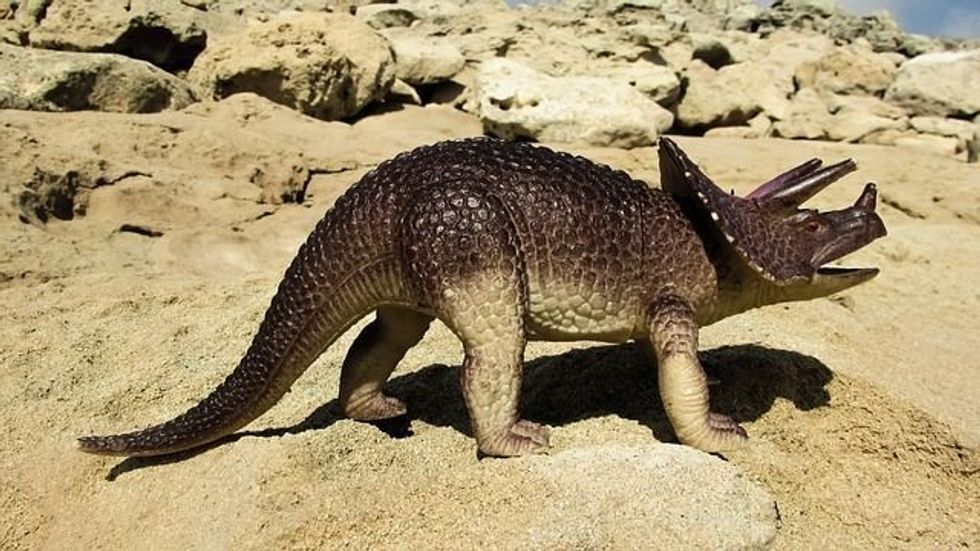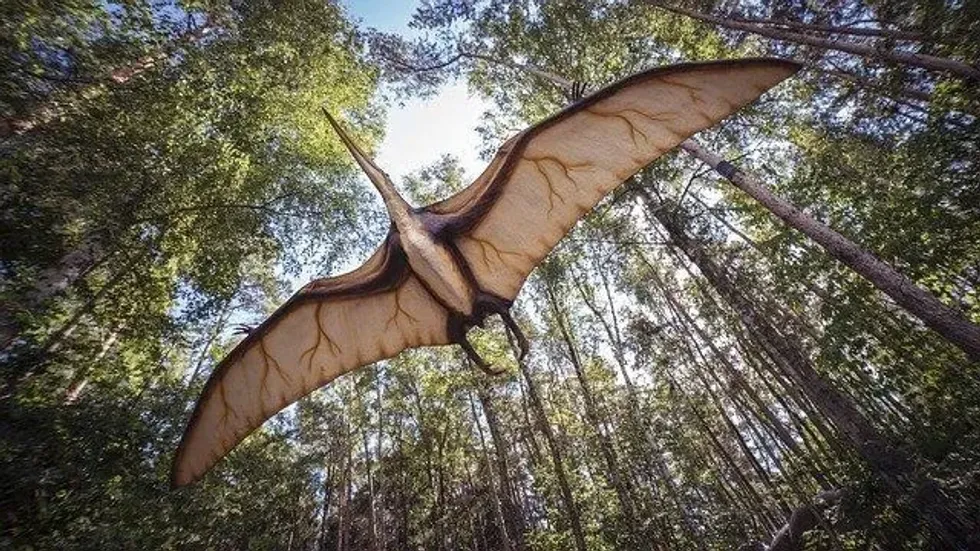The Bismarck flying fox (Pteropus neohibernicus) is also known as the great flying fox or greater flying fox and is a megabat of the family Pteropodidae. These megabats are also called Old World fruits bats.
Several contradicting pieces of evidence suggest that these species are close relatives of the spectacled flying fox or both the Pelew and insular flying foxes. These bats are the heaviest in the world and are the largest bats in Melanesia. These bats roost with many individuals in their life.
Wilheim Peters, a German naturalist, first described this species in the year 1876 after Carl Hüsker had collected a single holotype from Papua New Guinea. The specific name 'neohibernicus' is a Latin word meaning 'new Ireland'.
The two recognized subspecies of these bats are P. n. hill and P. n. neohibernicus. Due to varying coloration, they have various taxonomic synonyms, including Pteropus degener.
As per a 2019 study, the Pteropus genus is most closely related to the spectacled flying fox. Their suborder is Yinpterochiroptera and these species can cause various diseases in humans, including the Hendra virus.
Bismarck Flying Fox Interesting Facts
What type of animal is a Bismarck flying fox?
The Bismarck flying fox (Pteropus neohibernicus) is a megabat of the phylum Chordata, order Chiroptera, and suborder Yinpterochiroptera. All species of flying bats are highly intelligent and can be conditioned to learn and perform certain behaviors. This bat roosts in tall trees during the day, frequently along the coast.
They forage for fruit at night. The two subspecies of these megabats are P. n. hilli (Felten) and P.n. neohibernicus (Peters).
The Bismarck masked flying fox (Pteropus capistratus ) species is rare as these male flying bats can produce lactate. There are records that show that this large flying fox is restless during roosts, until mid-morning. Several roost trees are often found near human settlements.
What class of animal does a Bismarck flying fox belong to?
The Bismarck flying fox (Pteropus neohibernicus) is a megabat of the Mammals class of animals.
How many Bismarck flying foxes are there in the world?
The exact number of Bismarck flying fox (bat) animals is not known. There are around 16 extant species of bat or megabat around the world, many of which are Near Threatened or Vulnerable like the large flying fox and the spectacled flying fox.
Where does a Bismarck flying fox live?
The Bismarck flying fox of New Guinea, Bismarck Archipelago, is an endemic species of the country's southwest Pacific islands. The range and habitat these bats cover are different for the two subspecies. These species also occupy the Raja Ampat Islands in Papua New Guinea and Indonesia.
The subspecies P. n. neohibernicus are found in mainland New Guinea and New Britain. P. n. hilli occupies Admiralty Islands. Other small islands occupied by these bat species are Sakar Island, Karkar Island, and more.
What is a Bismarck flying fox's habitat?
The typical Bismarck flying fox (Pteropus neohibernicus) habitat range includes open forests, rainforests, mangrove, and Savannah woodlands. They occur in areas with an elevation between 0-4,593 ft (0-1,400 m) above sea level.
Who do Bismarck flying foxes live with?
The Bismarck flying fox (Pteropus neohibernicus), unlike masked flying foxes, form flocks consisting of several individuals. This is also the case with the large flying fox species.
How long does a Bismarck flying fox live?
The average Bismarck flying fox (Pteropus neohibernicus) lifespan is not known. However, their relatives, like the largest bat and endangered species, the golden-crowned flying fox and large flying fox, live up to 15 years of age. In captivity, they live up to 23 years of age.
How do they reproduce?
Bismarck flying fox (Pteropus neohibernicus) reproduction takes place in the summer months when a variety of fruits and nectar are available. Females produce a single live offspring.
It is believed that their offspring are born in early December. Half-grown young bats stay with their mothers. It is also assumed that the sexes separate and roost in different colonies, which is similar to the behavior of an insular flying fox.
What is their conservation status?
The conservation status of the Bismarck flying fox (Pteropus neohibernicus) is Least Concern. The conservation status of the large flying fox is Near Threatened on the International Union for Conservation of Nature (IUCN) Red List of Threatened Species.
The conservation status of the largest bat, the golden-crowned flying fox of the family Pteropodidae is Endangered on the International Union for Conservation of Nature (IUCN) Red List. The Bismarck flying fox, along with species of flying foxes, faces threats from the sea level rise due to climate change.
These endangered and threatened species are also affected by hunting for bushmeat. Hunting of these species is also popular due to their valuable teeth.
Bismarck Flying Fox Fun Facts
What do Bismarck flying foxes look like?
Bismarck flying fox (Pteropus neohibernicus) fur is golden brown in color. They are the largest bat species in New Guinea and Melanesia. Males have large canine teeth compared to females and they have a narrow snout and no tail.
Usually, fur on their back is absent, and if present, the fur is russet brown, dark, or pale brown. On their rump, the upper side of their thighs, and sides of their back, their fur is darkest in color.
On the center of their rump and back, their fur is light-colored. The dark brown fur on their head extends down to the sides of their head and in between the eyes. This is sometimes similar to a 'T' shape.

* Please note that this is an image of a brown and black fruit bat, not a Bismarck flying fox. If you have an image of a Bismarck flying fox, please let us know at hello@kidadl.com.
How cute are they?
The Bismarck flying fox (Pteropus neohibernicus) is considered very cute.
How do they communicate?
The Bismarck flying fox (Pteropus neohibernicus) uses echolocation to communicate. The signals emitted by this species are shot signals sent by a vibrating language. They also use their sense of smell.
How big is a Bismarck flying fox?
The average Bismarck flying fox size range is between 9.2-13 in (234-330 mm). A male's head and body are 10.5-13.0 in (266-330 mm) long and their forearm or wingspan is 7.5-8.1 in (190-206 mm) long. A female's head and body length is 9.2-11.0 in (234-280 mm) and her wingspan or forearm is 6.5-6.8 in (165-173 mm) long.
In comparison, the average Bismarck masked flying fox (Pteropus capistratus ) length is 4.3-4.6 in (109-117 mm) and the large flying fox has a head and body length of 11-13 in (28-33 cm) and its wingspan is 4 ft 11 in (1.5 m).
How fast can a Bismarck flying fox fly?
The flight speed of this species is not known.
How much does a Bismarck flying fox weigh?
This fruit-eating bat is 3.5 lb (2 kg) in weight. The large flying fox is of the same weight, measuring 1.4-2.4 lb (0.65-1.1 kg). Also, the largest bat, the golden-crowned flying fox weighs up to 3.1 lb (1.4 kg).
What are the male and female names of the species?
There is no specific name given to males and females of this species of bat.
What would you call a baby Bismarck flying fox?
There is no specific name given to a baby Bismark flying fox.
What do they eat?
The typical Bismarck flying fox diet includes fruits, flowers, and nectar. They also feed on figs. In fact, only three species out of all bats feast on blood.
Are they dangerous?
No, these creatures do not directly pose any threat to human beings. They are not naturally aggressive creatures and they tend to avoid humans. However, this mammal is a host to a zoonotic virus called the Hendra virus. This can affect horses through feces or infected fruit.
Only when humans come in contact with a sick horse do they contract this virus. So, veterinarians who could come in contact with these sick horses are at high risk. By hunting and eating the bat, its bushmeat also affects humans.
Would they make a good pet?
No, they would not make a good pet. These species thrive in open forests so should be left in their natural environment.
Did you know...
The Bismarck masked flying fox's habitat elevation is between 0-3,937 ft (0-1,200 m).
The average Bismarck masked flying fox size is smaller than that of the Bismarck flying fox. The typical Bismarck masked flying fox diet also includes fruit and other plant matter.
Pteropus capistratus of the family Pteropodidae were believed to be a subspecies of Temminck's flying fox (Pteropus temminckii).
The Bismarck masked flying fox (bat) is of the same genus as many other bats. Another bat, the Moluccan flying fox has been listed as Vulnerable and its population is decreasing because of logging. There are six species that are considered to be members of the Griseus species group within the genus Pteropus.
The large flying fox of the family Pteropodidae got their specific scientific name 'vampyrus' from the Slavic word 'wampir' meaning 'vampire'.
The genus Pteropus is made of two Ancient Greek words: 'pteron' means 'wing' and 'pous' means 'foot'.
These fruit bats mate while dangling on branches.
The conservation of status of the Rodrigues flying fox is Endangered as rated by the International Union for Conservation of Nature (IUCN).
These bat species are rarely threatened by predators. Pythons, owls, sea eagles, goannas, and crocodiles take only a few individuals from the roost.
What is the difference between a bat and a Bismarck flying fox?
Both bats and Bismarck flying foxes are true flying mammals. These flying foxes are one of the largest bats in the world and these flying foxes are fairly smart. They can recognize any intruders in their territory.
The majority of other species of bats are insectivorous whereas these Bismarck flying foxes are frugivorous. Bismarck flying foxes also have no tail, whereas microbats have tails. The Bismarck flying fox is of the suborder Yinpterochiroptera.
Why are they called the Bismarck flying fox?
These bats are named the Bismarck flying fox due to their habitat range. These bats occupy the Bismarck Archipelago, hence their name. Also, their heads resemble that of a fox so they are called a 'flying fox'. They are also called fruit bats because they love fruits.
You can even occupy yourself at home by coloring in one of our free printable Bismarck Flying Fox coloring pages.
* Please note that the main image is of a gray-headed flying fox, not a Bismarck flying fox. If you have an image of a Bismarck flying fox please let us know at hello@kidadl.com.










